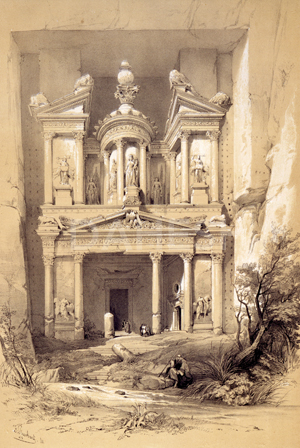After David Roberts, R. A. (British, 1796–1864)
Lithograph by François Stroobant,
El Khasnè
From The Holy Land. Views and Monuments. Brussels: Société des Beaux-Arts, 1843
Color lithograph, 15 7/8 x 10 1/4 in.
Inscribed lower left: F. Stroobant lith. 43. Inscribed lower center: Imp. Par J. Lots / EL KASNE
1999.12

“I am the first Art ist at least from England that has yet been here and there is much in this. The French work I now find conveys no idea of these splendid remains.” David Roberts made this diary entry in 1838 as he began his nine-month journey through the Middle East, an arduous trek that would take him up the Nile and through the desert to places few Westerners had been. Almost every significant site in Egypt and Palestine associated with biblical or ancient history was captured by Roberts’ pen. The result of this comprehensive topographical project was his six-volume opus The Holy Land, Syria, Idumea, Egypt, & Nubia, published by Francis Graham Moon in London in 1842-49. The book was translated into several languages and became immensely popular with the public—eager to see the panoramic landscape of Christianity—and other Orientalist artists. Roberts’ exact recording of architectural detail is on full display in this image of El Khasnè (Arabic for “The Treasury”), a famous site in Petra that the Swiss explorer Jean-Louis Burckhardt discovered in 1812. Although the monument was believed to be the treasury of a Pharaoh——because of its name which came from legend, it was probably a royal tomb of the Nabatean king Aretas IV, dating from the first century AD.


